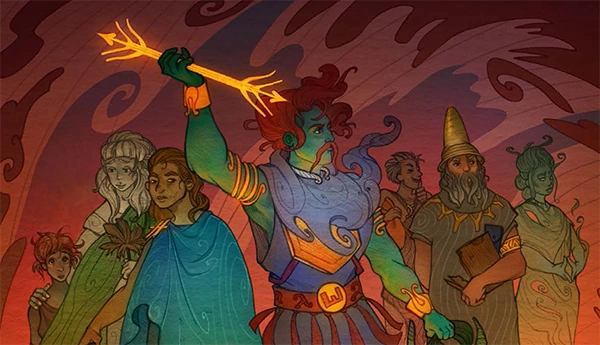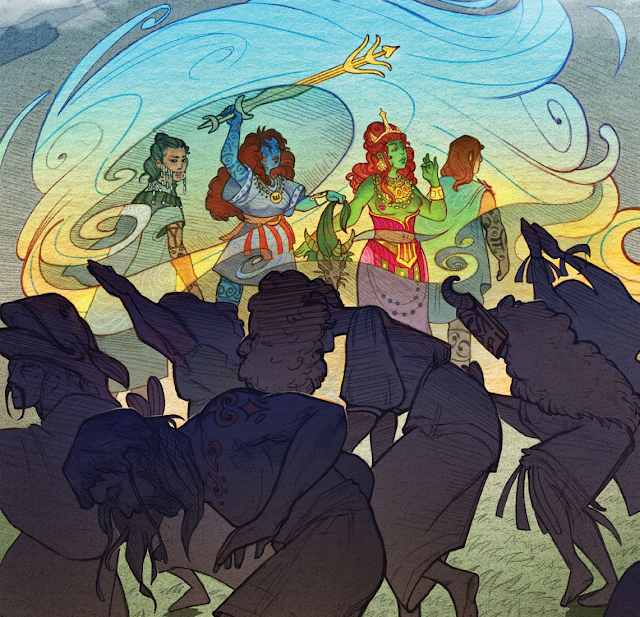These are my guidelines for HeroQuesting in Mythras.
First off, my main idea is that everyone should be able to become a superhero. Argrath heroquested for his power, Kallyr Starbrow and King Broyan did too, I see no reason why the characters should stay on the "powerful clansman" level.
What I want out of them is:
- A way to raise your characteristics and skills in a faster but unpredictable way, potentially going beyond the limits of a normal person.
- A way to get Gifts and other special magic items like the Helm of Vingkot
- A way to change the world, basically rituals that bring serious consequence to the world, from just making rain to something more serious
- Something about as fun as a dungeon
Their main categories are:
- This World heroquests, when you go into a trance and see things differently but still is here
- Other World heroquests, when you go in the Hero Plane and follow the story as best you can
- And Freestyle heroquests, when you go in the Hero Plane, or possibly even another world entirely, and just go nuts
So what I'm thinking is some guidelines for heroquests using these 3 paradigms in each of them
- I think This-World Heroquests can produce either results that are within the limits of the world, or are temporary. If you want to have more Strength, you will gain points with this one, but you'll never surpass the human maximum. Gifts are beyond these heroquests.
- Other World Heroquests ignore the limits of reality and/or are permanent. If you want to have more strength, you will truly become as strong as a bear and stronger than any man alive - if you can survive the horrible trial. This is how you get Gifts and mystical aid, like the Magic Sword & Helm of Vingkot. Still, you can basically only do what someone else has done before you.
- Freestyle Heroquests are how you get THE REAL shit. Completely new feats are done, such as obtaining the aid of a Dragon, bringing someone back from Lunar Hell, creating a new goddess who is also the moon, etc.
In a way, I see a Heroquest exactly like a Boast from Wolver Upon the Coast: the character is saying "I am good enough to do this, so I want the whole clan to bear witness to my doing it". A Freestyle Heroquest is more like the Trojan War, it's just something you kinda embark on and hope you can get something out of the deal.
This also means that you must be strong enough on your own to do a HeroQuest. If you're not strong enough to kill a dragon in the real world, you won't be able to go to the Other World and kill Aroka on your own.
And the other element that is in Adventures of Glorantha is how they use the concept of Feats from HeroQuest Glorantha, of which I'm a big fan. Basically, you channel the god's power fully and can use Rune Affinity to do something with the full power of the god, so Orlanth's Thunderer feat channels the full power of Orlanth and lets you "destroy with the Great Sound", so someone doing that would roll their Rune Affinity vs. whatever defense the opponent can muster.
I think channeling these Feats is absolutely instrumental for someone on a HeroQuest, and you need to HeroQuest to find more, which again drives home that you are a person being able to do the deed of a demigod. Your character isn't built different, he needs to quest for his power.
The nut I haven't cracked yet is combat stats. For This World quests it's easy, just use the numbers from the person or spirit standing in for that character in the quest; but for Other World HeroQuests, things get dicy. I'll probably have to adapt stats from other books and draw inspiration from that. We'll see.
I also intend on using Stations. That is, you and the players draw up roughly what are the main events of the story, what are the beats you must hit, then you put in weird shit between them or make one happen first, things like that to make it as interesting as a dungeon would be, and also to make it alive. The player knows where the story goes, after all.
Or you can do this all in HeroQuest and not worry about any of it.

